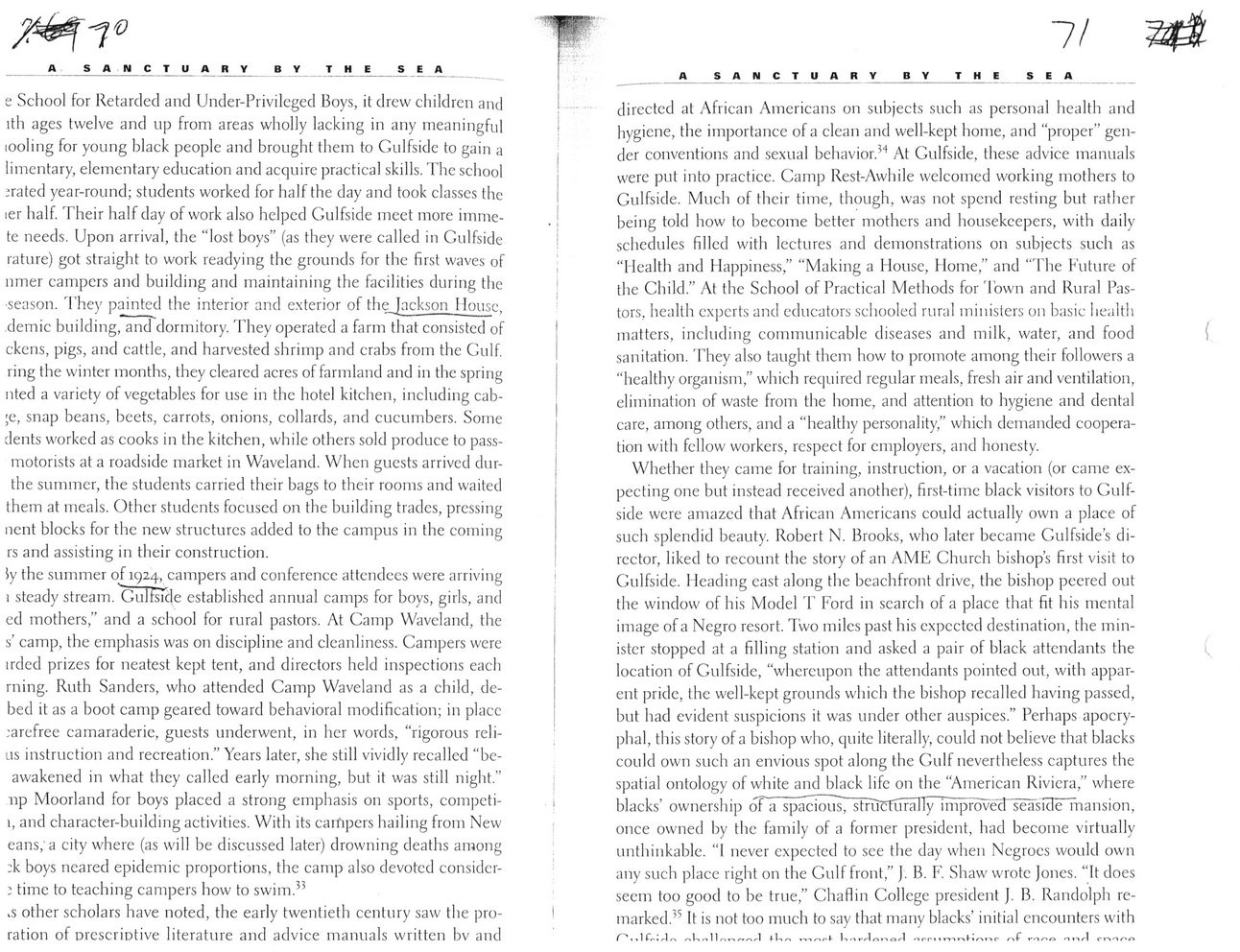This text was obtained via automated optical character recognition.
It has not been edited and may therefore contain several errors.
______A S A N C T U A R Y BY_________________THE S E A e School for Retarded and Under-Privileged Boys, it drew children and ith ages twelve and up from areas wholly lacking in any meaningful looling for young black people and brought them to Gulfside to gain a limentary, elementary education and acquire practical skills. The school crated year-round; students worked for half the day and took classes the ler half. Their half day of work also helped Gulfside meet more imme-te needs. Upon arrival, the “lost boys” (as they were called in Gulfside rature) got straight to work readying the grounds for the first waves of nmer campers and building and maintaining the facilities during the ■season. They painted the interior and exterior of the, Jackson Mouse, demic building, and dormitory. They operated a farm that consisted of ckens, pigs, and cattle, and harvested shrimp and crabs from the Gulf, ring the winter months, they cleared acres of farmland and in the spring nted a variety of vegetables for use in the hotel kitchen, including cab-;e, snap beans, beets, carrots, onions, collards, and cucumbers. Some dents worked as cooks in the kitchen, while others sold produce to pass-motorists at a roadside market in Waveland. When guests arrived dur-the summer, the students carried their bags to their rooms and waited them at meals. Other students focused on the building trades, pressing nent blocks for the new structures added to the campus in the coming rs and assisting in their construction. \y the summer of 1924, campers and conference attendees were arriving 1 steady stream. 'Gulfside established annual camps for boys, girls, and ed mothers,” and a school for rural pastors. At Camp Waveland, the s’ camp, the emphasis was 011 discipline and cleanliness. Campers were irded prizes for neatest kept tent, and directors held inspections each rning. Ruth Sanders, who attended Camp Waveland as a child, debed it as a boot camp geared toward behavioral modification; in placc .-arefree camaraderie, guests underwent, in her words, “rigorous reli-lis instruction and recreation.” Years later, she still vividly recalled “be-awakened in what they called early morning, but it was still night.” np Moorland for boys placed a strong emphasis on sports, compcti-1, and character-building activities. With its campers hailing from New eans,'a city where (as will be discussed later) drowning deaths among :k boys neared epidemic proportions, the camp also devoted considcr-1 time to teaching campers how to swim.33 ,s other scholars have noted, the early twentieth century saw the proration of DrescriDtive literature and advice manuals written bv and 7/ A SAN CTUARY BY THE SEA_________________________________ directed at African Americans on subjects such as personal health and hygiene, the importance of a clean and well-kept home, and “proper” gender conventions and sexual behavior.34 At Gulfside, these advice manuals were put into practice. Camp Rest-Awhile welcomed working mothers to Gulfside. Much of their time, though, was not spend resting but rather being told how to become better mothers and housekeepers, with daily schedules filled with lectures and demonstrations on subjects such as “Health and Happiness,” “Making a House, Home,” and “The Future of the Child.” At the School of Practical Methods for Town and Rural Pastors, health experts and educators schooled rural ministers on basic health matters, including communicable diseases and milk, water, and food ( sanitation. They also taught them how to promote among their followers a “healthy organism,” which required regular meals, fresh air and ventilation, elimination of waste from the home, and attention to hygiene and dental care, among others, and a “healthy personality,” which demanded cooperation with fellow workers, respect for employers, and honesty. Whether they came for training, instruction, or a vacation (or came expecting one but instead received another), first-time black visitors to Gulfside were amazed that African Americans could actually own a place of such splendid beauty. Robert N. Brooks, who later became Gulfside’s director, liked to recount the story of an AME Church bishop’s first visit to Gulfside. Heading east along the beachfront drive, the bishop peered out the window of his Model T Ford in search of a place that fit his mental image of a Negro resort. Two miles past his cxpcctcd destination, the minister stopped at a filling station and asked a pair of black attendants the 1. location of Gulfside, "whereupon the attendants pointed out, with apparent pride, the well-kept grounds which the bishop recalled having passed, but had evident suspicions it was under other auspices.” Perhaps apocryphal, this story of a bishop who, quite literally, could not believe that blacks could own such an envious spot along the Gulf nevertheless captures the spatial ontology of white and black life on the “American Riviera,” where blacks’ ownership oTa spa"ciou7, stru^Turally improved’ seaside mansion, once owned by the family of a former president, had become virtually unthinkable. “1 never expected to see the day when Negroes would own any such placc right on the Gulf front,” J. B. F. Shaw wrote Jones. “It does seem too good to be true,” Chaflin College president J. B. Randolph remarked.35 It is not too much to say that many blacks’ initial encounters with

Gulfside Methodist Assembly Land-was-Ours---book-Kahrl-(07)